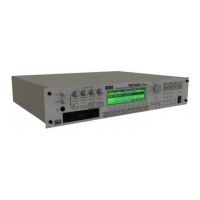20
When you adjust the cutoff frequency of the filter, the
brightness of the sound will change. The effect will
depend on the settings of the program parameters, but
normally, rotating the knob toward the left will darken
the sound, and rotating it toward the right will
brighten it.
Knob [2]: RESONANCE/HPF
Adjusts the resonance level of a low pass filter or the
cutoff frequency of a high pass filter.
The content that is controlled will depend on the filter
type specified by the program.
By adjusting the filter resonance level, you can increase
or decrease the resonance level to add a unique charac-
ter to the sound.
By adjusting the cutoff frequency of a high pass filter,
you can modify the brightness of the sound.
Knob [3]: EG-INTENSITY
Adjusts the filter EG intensity (the depth at which the
filter EG is applied).
Rotating the knob will affect the depth of the filter EG.
Normally, rotating the knob toward the left will make
the filter EG apply less deeply, and rotating it toward
the right will make the filter EG apply more deeply.
Since the filter EG will operate based on the cutoff fre-
quency of the filter, knobs [1] and [3] will work
together to control the tonal changes produced by the
filter.
Knob [4]: EG-RELEASE
Adjust the EG release times of the filter and amp. This
will determine the time from note-off until the sound
disappears.
When you operate the knob, the release times of the fil-
ter EG and the amp EG will change. Normally, rotating
the knob toward the left will shorten the release time,
and rotating it toward the right will lengthen the
release time.
When the arpeggiator is running, it is effective to use
this in conjunction with the C-mode [ARP-GATE] knob
to control the arpeggiated notes.
B-mode controls
You can control parameters such as volume, porta-
mento time, pan or filter and amp EG, pitch LFO, and
master effect send levels etc.
In each preloaded program, appropriate functions are
assigned to the B-mode knobs.
The B-mode function settings are made for each indi-
vidual program, combination, or multi. In Sampling
mode, the B-mode functions are set for the entire
mode.
For details on making these settings (
☞p.100).
C-mode controls
You can control the arpeggiator in realtime. For details
on operation, refer to the following page.
Viewing the parameters that are assigned to the B-
mode REALTIME CONTROLS and “SW1,” “SW2”
In Program, Combination, and Multi modes, the 1.1:
Play page lets you view the parameters that are
assigned to the B-mode of realtime control knobs [1],
[2], [3], and [4] and to “SW1” and “SW2.”
SW1, SW2
You can use these keys as sources for alternate modula-
tion or effect dynamic modulation to control program
parameters or effect parameters.
These switches can also be used to turn portamento
on/off.
You can specify the way in which the “SW1” and
“SW2” will operate: either Toggle, when the assigned
function will be switched on/off each time the [F6],
[F7] key is pressed, or Momentary, when the assigned
function will be switched on only as long as you hold
down the key.
When you write a program or combination, the
on/off status of the “SW1” and “SW2” is saved.
For details on making these settings, refer to Set-
ting the functions of “SW1” and “SW2” (
☞p.100).
Frequency
HighLow
Cutoff
frequency
Level
LPF
Level
Cutoff
frequency
LPF HPF
Level
Time
Level
Time
Attack Time
Decay Time
Slope Time
Release Time
Attack Level
Start Level
Sustain Level
Break Level
note-on
note-off
Release Level
Functions assigned to
“SW1” and “SW2”
Functions assigned to
B-mode knobs [1]–[4]
“SW1” “SW2”

